Support and Resistance For Technical Online Trading
If you are in a city you’ve never been in before, you use landmarks to help you get from one place to another without getting lost: a tall church, a skyscraper or any other easily identifiable object. Support and Resistance (S/R) is your skyscraper on the chart, your point of reference that helps you navigate the markets. It is the basis of technical trading and all traders should include it into their education. The concept of S/R is the basis for many tools, many strategies and is bandied around by traders like it’s the greatest buzzword every created. Thus, since it’s such an important topic and the fundamental part of charting, we need to learn more about it and that’s exactly what we are going to do. Strap in!
The Basics of Support and Resistance
The most common definition of support and resistance is that an area where price movement is likely to be stopped. Support will stop a downtrend, resistance will stop an uptrend, but none of that really explains why price movement will stop. To understand that we have to consider the market, its participants and the valuation of assets.
When an asset’s price retreats to levels that the market deem are low (undervalued) traders buy and their buying provides support for prices. Any time prices reaches those levels buyers step in and their buying prevents prices from declining further, it is said to support them. The same thing is true for resistance. Market participants determine when an asset is overvalued and use that price as a trigger to sell. The more people who agree that an asset is overvalued and sell, the stronger that resistance will be. The easiest way to see this is on a chart, the peaks are areas of resistance the troughs are areas of support.
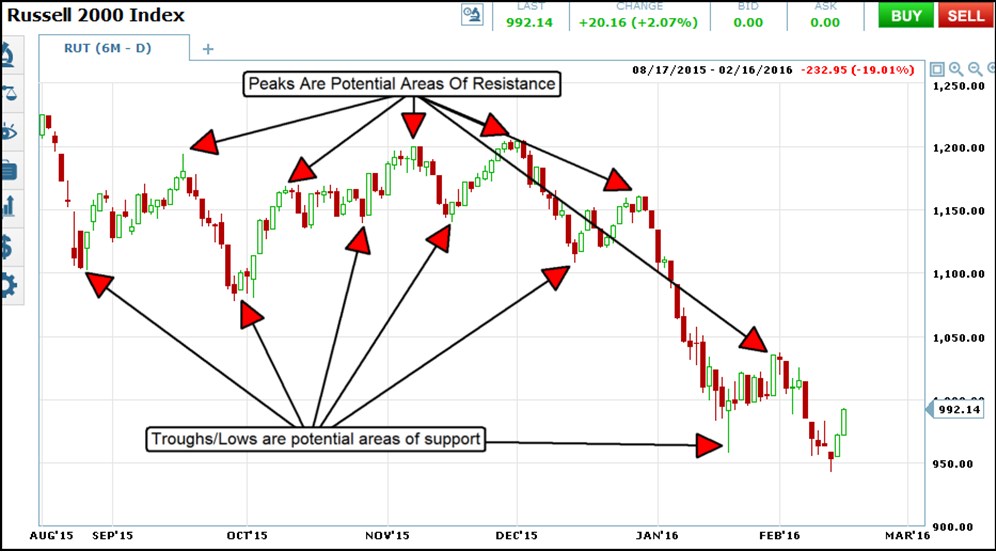
Not all support or resistance levels are the same and this is because there are long term traders, medium-term traders and short term traders, all making decisions based on different types of information. Typically, the longer the outlook the more significant the potential for support or resistance. For example, a long term 200-day moving average is often used by institutional investors and provides stronger support/resistance than a 30-day moving average which is used by short term traders. Long term traders focus on fundamentals like cash flow and profits, short term traders focus on news and emotion, trading on swings in the market. There is more long term money in the market than there is short term, the more money you can expect to provide support or resistance at a certain level the stronger that level will be.
Drawing Support And Resistance Lines
Drawing support and resistance lines is very subjective. There are quite a few different methodologies and frankly, they are all pretty good. What makes one line stronger than another is confirmation, but I’ll go over that later. The simplest way to pick a potential line is to look for peaks and troughs in the market, it doesn’t matter if the market is ranging or trending there will be areas of support and resistance. The first possibility will be the highest high or the lowest low including the tips of upper or lower shadows. For more on candles and how to read them go to this article, Japanese Candlesticks – Trading Naked.
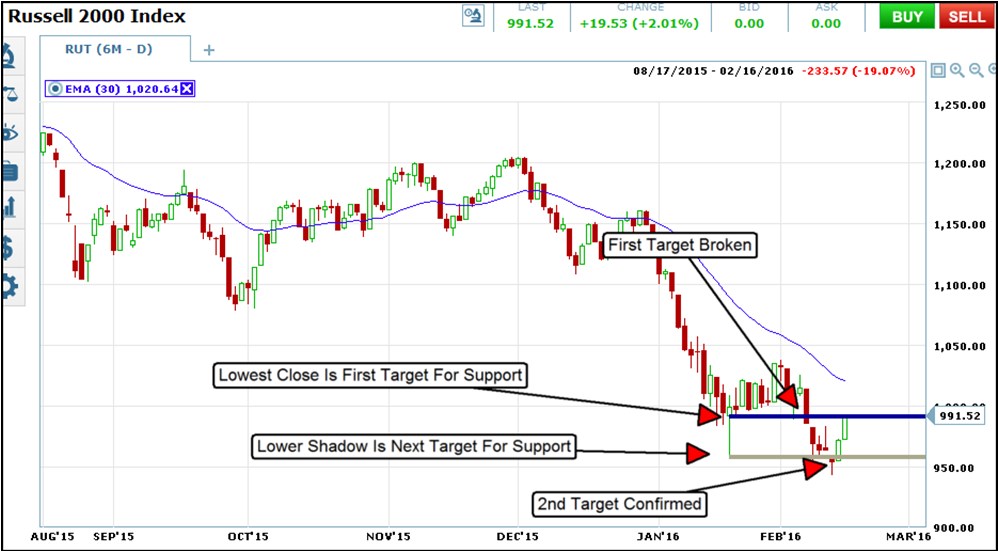
In the above example the lowest close of a downtrend is the first target for support if broken the tip of the lowest shadow becomes the next target. This is because these are important price levels for buyers. The first target is where buyers overpowered sellers and pushed prices higher, the second is the trigger price that got the bulls buying in the first place. The same is true for resistance levels, the thing to remember is that the strength of the level is directly related to the number of traders who think it is good for buying or selling. The more times a level is reached and provides support and resistance the stronger it gets. In the above example the 2nd target is hit, then tested and confirmed making it a little bit stronger than it was the first time. If the bounce continues the high set on Feb 1 is the first target for resistance.
Support and Resistance can be identified with the help of the Fibonacci tool as well as Pivot Points. The advantage of such tools is that they are used by many traders so they become somewhat self-fulfilling. We’ve prepared articles for each of these tools so if you want to learn more, check them out: QuickFib – A little Fibonacci Help Could Do Miracles and Pivot Points – Support and Resistance on Auto-Mode. Also, there is another form of Support and Resistance: dynamic S/R. This is provided by Moving Averages and it’s called “dynamic” because it constantly moves, adjusting to price action. A good way to get the feel of Moving Averages, as well as horizontal S/R, is to read Okane’s Homegrown Price Action Strategy for EUR/USD.
Gauging The Strength Of Support And Resistance
Support and resistance have a big impact on trend and trend following strategies. In fact, the trend is actually a measurement of the progression of support or resistance levels, a sideways trend merely the test and retest of the same support level. Say for example an asset touches down to the 200 bar long term moving average, a commonly used measure of long term support. The moving average provides support and prices rise above the 100 bar moving average, the rise in prices attracts traders who use the 100 bar moving average and they buy when prices touch back to their target level, then their buying pushes prices above the 30 days moving average and attracts another group of traders and further strengthens the trend. Each level is a support level and the higher levels are in term supported by lower levels. The example below shows how this concept works in a bear market.
- Two strategies that make good use of the moving average for support and resistance are the Guppy Strategy and the Geek’s Simple Moving Average Strategy.
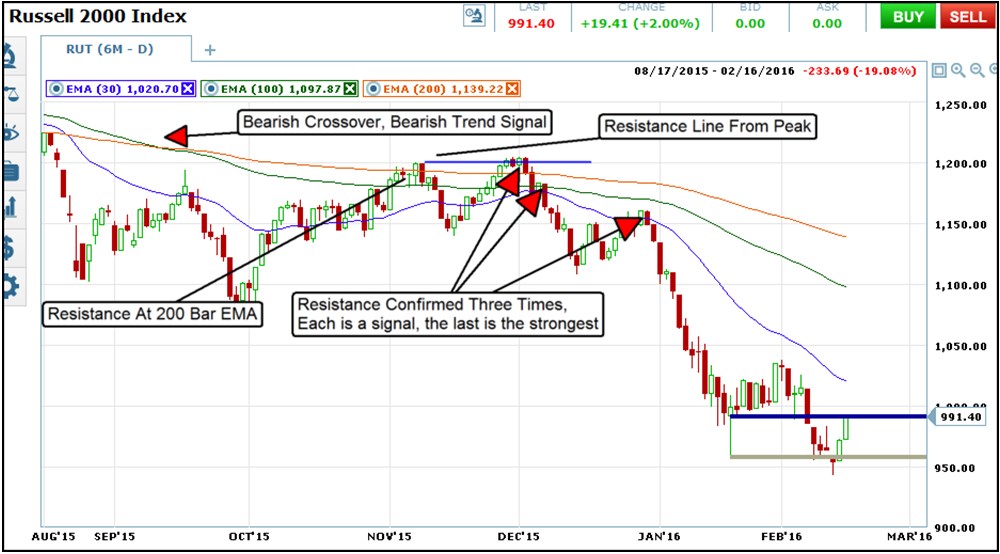
This same concept, the convergence of support or resistance levels, can be applied to multiple indicators as well as to multiple time frames. If you are finding signs of support using one indicator, and another indicator confirms it, that support is likely to be stronger than if only one indicator showed support because there are two different groups of traders in the market at that level. One example might be is Bollinger Bands ™ showed a bottom at the same place as Fibonacci Retracement, or if a pin-bar signal appears where a short term moving average crosses below a longer-term one.
In the example below you can see where the Bollinger Bands ™ provide support and resistance. They do this in the near term, for short moves, but when the signal confirms with other signals the subsequent price move is more pronounced. A tool that I really like is the Stochastic Oscillator, it can predict and confirm support and resistance levels as well as give a multitude of profitable entry signals. Read this for more details on how to use Convergence of Indicators in your analysis.
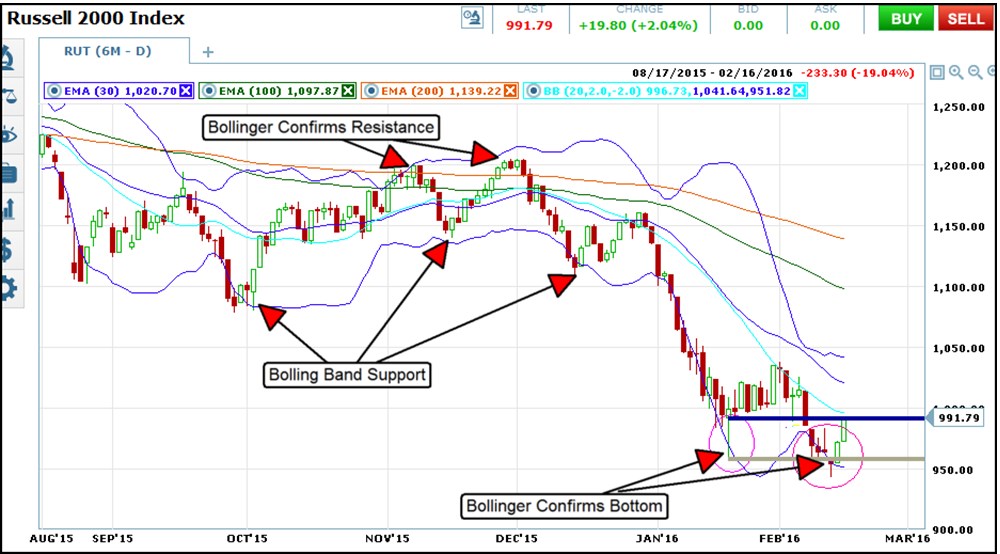
Automated Tool for Drawing Support and Resistance on Your Charts
Thus far we’ve talked about the importance of Support and Resistance in trading but let’s assume you are just getting started with all this charting and technical analysis stuff and that you need a little help identifying S/R. It can be hard for a newbie to understand what level is reliable or important and what level is not, so until you improve your skills to identify S/R levels, you can use the indicator we are going to talk next. It is called “Support – Resistance” and I think the name is self-explanatory: the indicator finds and draws Support and Resistance levels on trading charts. Let’s see what use we can make of it:
How to Use the Custom Indicator?
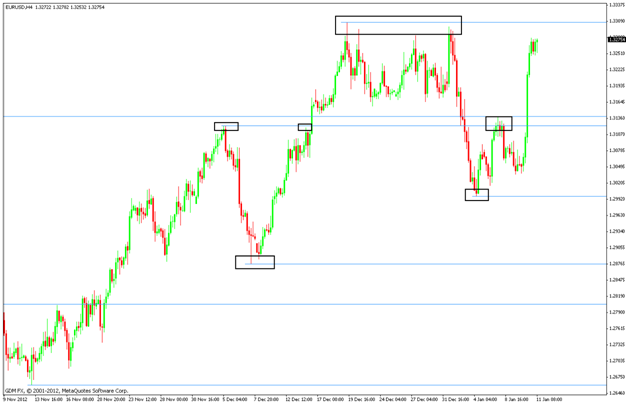
In the pic above you can see the indicator in action. It is not too impressive at first glance, I know. But S/R levels are not graphically impressive; after all they are just lines… just lines that can make us money if used correctly. Now let’s do a little recap:
Resistance is a level that rejects rising prices into the lower territory. The more times the level rejects price, the stronger it becomes.
Support is a level that rejects falling prices into higher territory. Just like Resistance, Support becomes stronger if it rejected price many times in the past.
If price reacted in the past to a certain level, it is likely to do so again in the future but don’t imagine that an S/R level will never be broken. That would mean price is never trending, right? And you need good trends to increase your In-The-Money ratio. For a quick and easy trend-following strategy, read The Trend is Your Friend Strategy. If you feel more adventurous and care to try a more complicated approach to trend trading, read my Getsuga Tensho Strategy.
The catch is identifying good support and resistance levels and watching price react around them. Another important thing to remember about S/R is that a broken Support can turn into Resistance and vice versa. Check out the picture below:
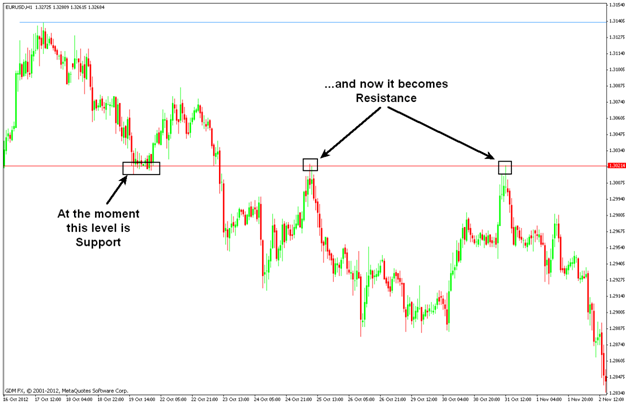
Ok, we’ve talked enough about Support and Resistance levels so let’s focus on the indicator a bit more! After downloading it (see bottom of this article) and installing it, close your MT4 platform (if you have it open) and then re-open it. For the next step you have to click on Insert – Indicators – Custom – Support-Resistance and then click OK on the little box that will appear. That’s it! Support and Resistance lines will be automatically drawn on your charts and will be updated if new S/R appears. If you change the timeframe, you will see S/R lines for that timeframe, which is great. Now let’s see what sucks about it:
Why Does the “Support – Resistance” Indicator Suck?
No computer program will be able to identify correctly and with 100% accuracy the best levels of Support and Resistance (at least I never came across one that does). I like to draw my own S/R levels, but if a novice has no idea about how to draw them, this indicator is better than not having S/R levels at all on your charts. Being an automated indicator, it cannot understand that Support and Resistance is a zone rather than an exact level and therefore, the indicator draws more than one line in an S/R zone. Look at the two pictures below to understand better what I am trying to say:
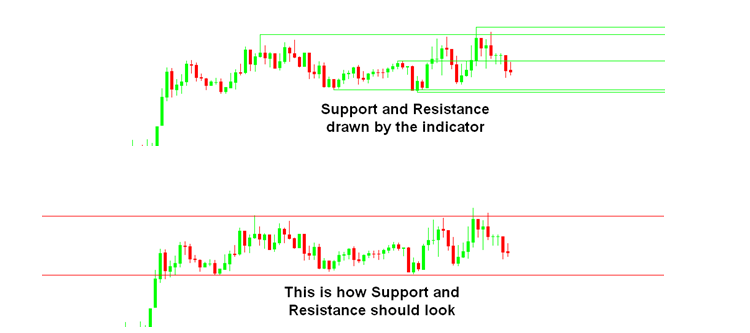
See how many lines the indicator draws? In this particular case, the indicator incorrectly draws more lines than needed. However, it is not something to be worried too much about because since you know about the problem, you can avoid it easier: just be aware of the fact that sometimes 2 lines very close together are actually a zone of Support or Resistance.
Why “Support – Resistance” Doesn’t Suck?
I think every trader should have some knowledge about support and resistance as it is an important part of trading. But in the beginning, S/R levels seem too complicated and hard to identify. At least that’s how it was for me and that’s what makes this indicator valuable. Think of it like some training wheels on your bike when you first learn to ride it; it helps, although a rider using training wheels will never go as fast as one that is experienced and doesn’t need them. With time, you will learn to ride with no training wheels on.
But, this is not a strategy and you should never forget that. Do not use the indicator alone when you trade. Instead, rely on it for confirming your strategy and helping you to see the price waves better. When you feel comfortable enough identifying your own levels, just delete it from your charts or keep it only to confirm the levels that you found. For more custom indicators, you can visit our Tools page
Wrapping It Up
Hopefully I haven’t confused you too much. If there are any questions don’t hesitate to get in touch with us and I will be happy to oblige. The bottom line is that support and resistance is a crucial concept for all traders to know. Choosing the best ones takes practice, and the confirmation of other indicators adds to their strength. My advice is to keep practicing drawing lines, look at how lines from past peaks and troughs affect future price action. Look at how other indicators interact with the lines that create the strongest signals and eventually you will be able to see major turning points in the market without even trying. And if all that overwhelms you, just use the indicator we’ve provided and your S/R lines will be automatically drawn on the chart.